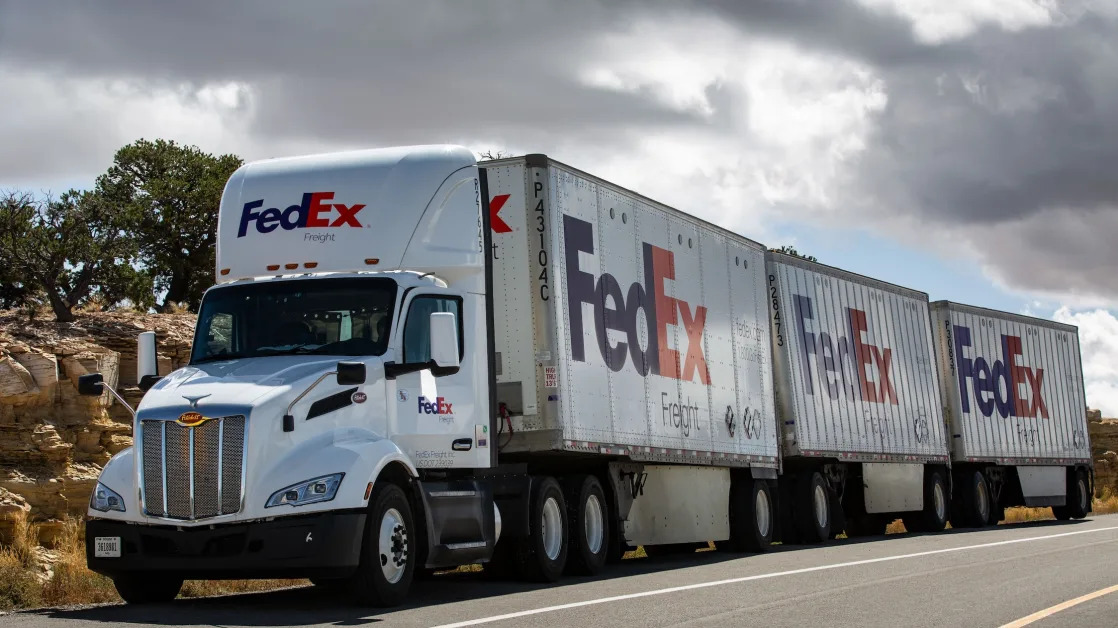
FedEx is spinning off its less-than-truckload (LTL) business.
After months of debate on what to do with FedEx Freight, the logistics giant decided it would separate the division into a standalone publicly traded company within 18 months.
More from Sourcing Journal
The freight division is already the largest LTL carrier in the U.S. by revenue, bringing in sales of $9.4 billion and $1.8 billion in operating income in fiscal 2024. As of June 7, the segment operated nearly 30,000 vehicles out of a network of approximately 360 service centers and had approximately 40,000 employees.
The spinoff announcement coincided with FedEx’s second-quarter earnings release, in which total revenue at the company dipped 0.9 percent to $22 billion, while net income totaled $741 million.
FedEx Freight weighed down total revenue at the Memphis-based courier, seeing declines of 11 percent to $2.2 billion, while operating income plummeted 36 percent to $312 million. Lower volumes, fuel surcharges and weight per shipment drove the top-line decline, said chief customer officer Brie Carere in an earnings call.
“Year-over-year comparisons were challenging as some customers won last year from the Yellow bankruptcy have since left in search of lower prices,” said Carere. “That being said, we are ready to capture additional profitable volume when the market returns.”
According to Carere, FedEx anticipates that the second quarter was “the trough” for the freight segment’s revenue.
Wall Street initially responded well to the spinoff and earnings results, with FedEx stock jumping more than 9 percent in Thursday after-hours trading. But the overnight high had subsided by Friday morning, with the stock sinking lower than Thursday’s closing share price by 10 a.m.
According to a research note from Barclays published last month, the spinoff could unlock $10 billion to $20 billion in incremental shareholder value. Currently, FedEx has a market capitalization of $67.2 billion, including both major reporting segments Federal Express and FedEx Freight.
For comparison’s sake, chief LTL competitors like Old Dominion Freight Line and XPO have a market capitalization of $38.2 billion and $15.6 billion, respectively.
The FedEx Freight spinoff comes amid a wider restructuring for the logistics giant focused primarily on cutting costs and making its delivery network more efficient.
The initiatives underway through its Drive transformation plan are expected to create $4 billion in cost savings by the end of fiscal year 2025, while the Network 2.0 delivery consolidation strategy is targeted to generate savings of $2 billion by the end of fiscal year 2027.
Lost in the split news was the overall impact of weak parcel demand, which has pervaded throughout rivals such as UPS and DHL . Average daily package volume decreased 1 percent to 17.1 million parcels per day in the Federal Express segment, which encompasses its air and ground delivery. Average daily shipments for FedEx Freight saw a wider decline at 8 percent to 91 million.
Like both companies in their most recent earnings call, FedEx trimmed its full-year guidance to approximately flat revenue year over year, compared to the prior forecast of a low single-digit percentage increase. Additionally, adjusted earnings per share is now expected at $19 to $20, compared to a prior expectation of $20 to $21 per share.
Separating the freight unit from the parcel delivery business follows a similar move UPS made in 2021. The difference is that UPS exited the industry entirely when it sold off its own LTL business, UPS Freight, to TFI International for $800 million. TFI since rebranded that unit to TForce Freight.
For FedEx, the company feels the spinoff allows FedEx Freight to “play offense” in grabbing more volume and competing for more business, according to Carere.
“While our weight is down right now in our base because of the macro, when we look competitively, we think there is some opportunity using technology to fill up the capacity,” said Carere. “We know the FedEx Freight network right now can run very comfortably at 100 million to 105 million [daily shipments], so we’ve got some opportunity to be a little bit more strategic, also to look at the 3PL market.”
CEO Raj Subramaniam said the unit has appointed a new vice president of LTL sales, Thomas Connolly, and expects to add more than 300 LTL sales specialists by the time of separation. Currently, the division has about 75 sales reps.
Additionally, Subramaniam said there would be an “enhanced LTL-specific pricing and invoicing system that drives faster speed to market, more intuitive contracts and is more tailored to this particular market.”
Carere also clarified that current LTL contracts will all be honored under the split. The “vast majority” of contracts are renegotiated every year.
“If you look at the majority of the FedEx Freight revenue base today, while the majority of small customers are bundled, the majority of the actual volume at FedEx Freight is negotiated on an independent contract,” Carere said. “We really made a pivot about four or five years ago where we recognized that when we were competing in a fragmented market, we had to negotiate the freight business separately.”
FedEx will remain a customer of FedEx Freight following the split. Lance Moll will continue to serve as president of FedEx Freight through the separation process.


